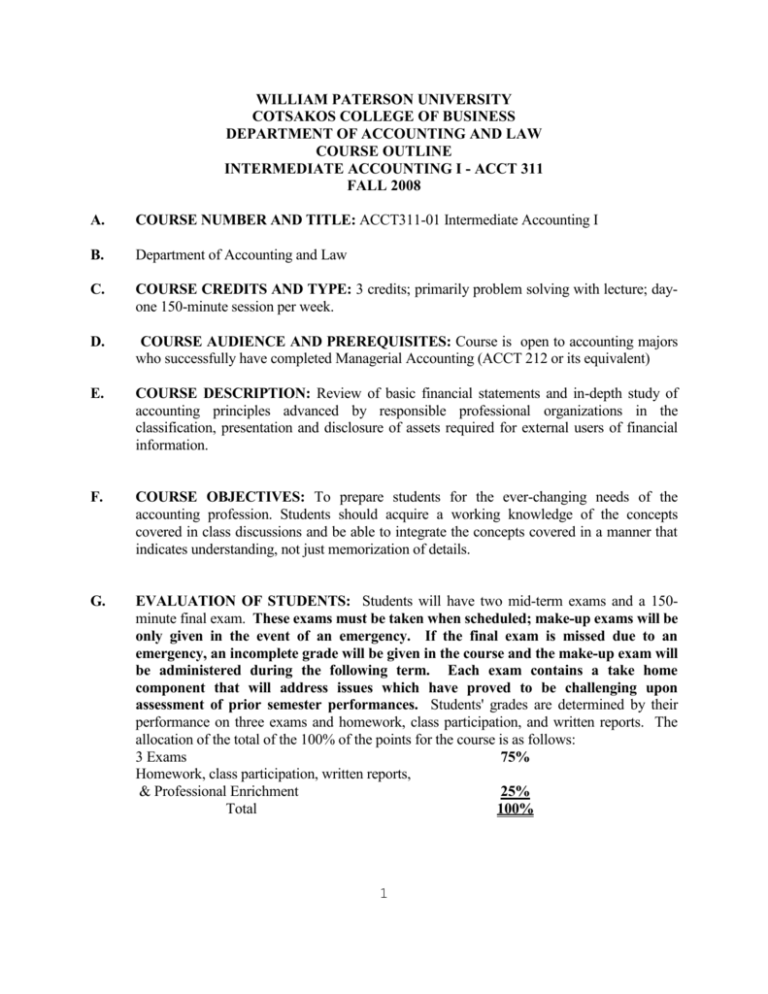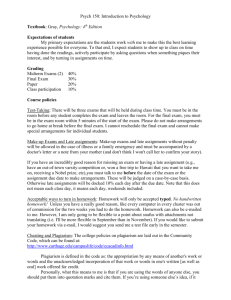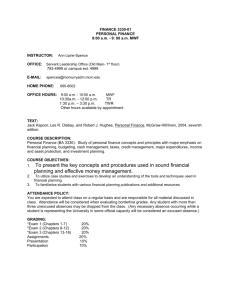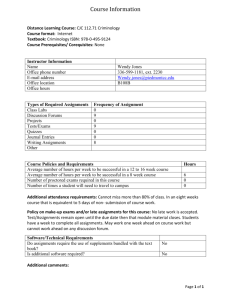monmouth university - William Paterson University
advertisement

WILLIAM PATERSON UNIVERSITY COTSAKOS COLLEGE OF BUSINESS DEPARTMENT OF ACCOUNTING AND LAW COURSE OUTLINE INTERMEDIATE ACCOUNTING I - ACCT 311 FALL 2008 A. COURSE NUMBER AND TITLE: ACCT311-01 Intermediate Accounting I B. Department of Accounting and Law C. COURSE CREDITS AND TYPE: 3 credits; primarily problem solving with lecture; dayone 150-minute session per week. D. COURSE AUDIENCE AND PREREQUISITES: Course is open to accounting majors who successfully have completed Managerial Accounting (ACCT 212 or its equivalent) E. COURSE DESCRIPTION: Review of basic financial statements and in-depth study of accounting principles advanced by responsible professional organizations in the classification, presentation and disclosure of assets required for external users of financial information. F. COURSE OBJECTIVES: To prepare students for the ever-changing needs of the accounting profession. Students should acquire a working knowledge of the concepts covered in class discussions and be able to integrate the concepts covered in a manner that indicates understanding, not just memorization of details. G. EVALUATION OF STUDENTS: Students will have two mid-term exams and a 150minute final exam. These exams must be taken when scheduled; make-up exams will be only given in the event of an emergency. If the final exam is missed due to an emergency, an incomplete grade will be given in the course and the make-up exam will be administered during the following term. Each exam contains a take home component that will address issues which have proved to be challenging upon assessment of prior semester performances. Students' grades are determined by their performance on three exams and homework, class participation, and written reports. The allocation of the total of the 100% of the points for the course is as follows: 3 Exams 75% Homework, class participation, written reports, & Professional Enrichment 25% Total 100% 1 H. GRADING : All grades will be administered according to the following standard: A: A-: B+: B: BC+: C : C- : D+: D: F : 93% - 100 % 90% - 92% 87% - 89% 83% - 86% 80% - 82% 77% - 79% 73% - 76% 70% - 72% 65% - 69% 60% - 64% 59% or below I. TEXTBOOK: Intermediate Accounting by D. E. Kieso, J. J. Weygandt, and T.D. Warfield (Twelfth Edition), Publisher: John Wiley & Sons, Inc., 2007. J. CONTACT: DR. Sia Nassiripour OFFICE: 1600 Valley Road – Room 4073 OFFICE HOURS: T: 10:30-2:00 W: 10:30-11:00 & 1:30-2:00 TH: 10:30-12:15 & 2:15 - 6:45 TELEPHONE: (973) 720-2241 FAX: (973) 720-3722 E-MAIL nassiripours@wpunj.edu K. TEACHING METHODS: Explanatory lectures prepare students to complete assignments that are reviewed in class. This course involves a substantial study commitment from students. Text reading assignments are to be completed prior to the class in which the material is introduced. Problem assignments must be completed (or worked as far as possible on a "best efforts" basis) prior to the class period during which they are to be reviewed. Participation in class discussion and problem-solving exercises is expected. Being successful at accounting requires lots of practice, so spending time on the assigned homework is essential in understanding of the material. Homework problems have been chosen to reinforce the learning objectives presented in each chapter. Each class will be devoted to a concise lecture of the material in the textbook. Initially the major points of each chapter will be reviewed by the professor. This brief discussion will be followed by a discussion of the assigned problems. Every student is expected to come to class fully prepared to participate in discussion and review of all assignments. 2 L. ACADEMIC INTEGRITY POLICY: The University has an obligation as an educational institution to be certain that each student's work is his/her own. Dishonesty in such academic practices as assignments, examinations, or other academic work cannot be condoned. Anyone caught cheating on an exam or assignment will be given a zero (0) for such exam or assignment. Remember cheating includes plagiarism. M. ATTENDANCE POLICY: Attendance and homework are important and will be taken at random and will affect the course grade. Each student will be allowed three unexpected absences after which five points will be deducted from the student’s total points. Any student who misses a class is responsible for obtaining notes from a classmate regarding any changes in assignments, exam dates, material covered in class, etc. N. MAKE-UP POLICY: Make-up exams are given only in cases of sever emergency and must be completed within a week of returning to school. O. GROUP PROJECT AND WRITING ASSIGNMENT: Group Project: To assist students in relating accounting concepts from this course to the real world, you will be completing a group project dealing with one of the topics covered in the course. A group can be up to 3 to 4 students, formed on voluntary basis. The professor must approve the topic for each group. Each group must prepare a folder of articles that were used as sources for the report. Prepare a double spaced report. In addition, you should obtain (using Internet or otherwise) the most recent financial statements of the firms involved, if any. P. TENTATIVE TOPICAL OUTLINE OF COURSE CONTENT Chapter Ch. 1 – Financial accounting & Accounting Standards Homework Assignments Ch. 2 – Conceptual Framework E 2, 3, 4, CA2- 4 COMPARATIVE ANALYSIS CASE Ch. 3 – The Accounting Information System E 5, 21, 20, P 4 RESEARCH CASE COMPARATIVE ANALYSIS CASE Ch. 4 – Income Statement & Related Information P 3, 4, CA 4, 8, 9 RESEARCH CASE 1 CA1-1, CA1-2 3 Ch. 5 – Balance Sheet & Statement of Cash Flows E 12, 17, P 5, CA 4 RESEARCH CASE Ch. 7 – Cash & Receivables E 2, 3, 7, 16, 17, 18, P 2, 13, 9 COMPARATIVE ANALYSIS CASE PROFESSIONAL SIMULATION (Extra Credit) Ch. 8 – Valuation of Inventories: A Cost Basis Approach E 11, 14, 25, P 2, 3 RESEARCH CASES: CASE 1 PROFESSIONAL SIMULATION (Extra Credit) Ch. 9 – Inventories: Additional Valuation Issues E 3, 12, 20, 25, 10, P 11, 14 COMPARATIVE ANALYISI CASE Ch. 10 – Acquisition & Disposition of Property, Plant, & Equipment E 1, 3, 8, 14, 22, 23, P 8 Financial Statement Analysis Case Ch. 11 – Depreciation, Impairment, & Depletion E 2, 5, 13, 16, 17, 22, 24 P 2 & P10(Extra Credit) FINANCIAL REPORTING PROBLEM: Procter & Gamble COMPARATIVE ANALYISI CASE 4








